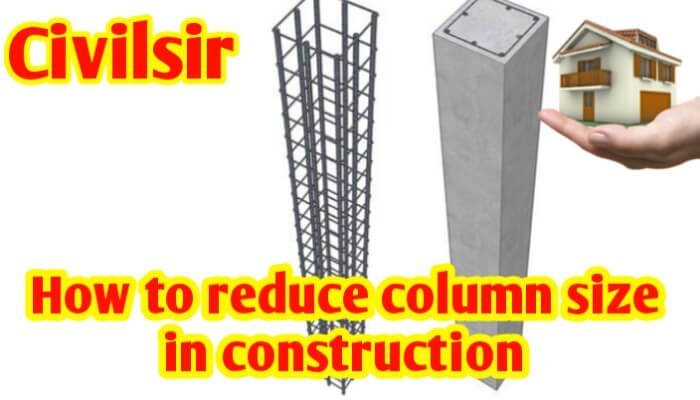Reducing column size in construction typically involves consulting with a structural engineer to ensure safety and compliance with building codes. Consider alternative materials or designs that maintain structural integrity while minimizing column dimensions. Reducing column size in construction can be achieved through various strategies:
1. High-Strength Materials: Use high-strength materials like high-strength concrete or advanced composite materials that allow for smaller column sections while maintaining structural integrity.
2. Reinforcement: Implement effective reinforcement techniques, such as using steel bars or mesh within the columns, to enhance their load-bearing capacity and reduce the required size.
3. Innovative Design: Work with architects and structural engineers to develop innovative designs that distribute loads efficiently, minimizing the need for larger columns.
4. Post-Tensioning: Consider post-tensioning methods, which involve applying internal forces to the structure after it’s built. This technique can help reduce the size of columns by improving their performance under load.
5. Advanced Construction Technologies: Explore modern construction technologies, such as precast concrete or composite materials, to achieve higher strength and durability with smaller columns.
6. Computer-Aided Design (CAD): Utilize computer-aided design tools to optimize column sizes based on structural requirements, ensuring efficiency in material usage.
Today is day of modern era of construction in civil engineering in multi storey building, development of heavy Industrial Area, heavy structural like Bridge, dams power plant and high rise building are constructed due to today demand of crowded population and living standards of peoples in most of country.
◆You Can Follow me on Facebook and Subscribe our Youtube Channel
You should also visits:-
1)what is concrete and its types and properties
2) concrete quantity calculation for staircase and its formula
Due to heavy loaded structure or high rise building construction there is a huge size of cross section of column/vertical support and should be required, that makes architecture appearance looking not so good and do not fit in available space. So there is talent need of architectural engineer drawing of heavy loaded structure “how to reduce column size in construction”. Resize the column which have good architectural appearance, looking beautiful in home design and feet into available given space.

How to reduce column size in construction:- for heavy loaded Industrial Area, multi storey building and apartment, whose acting axial load on column very high,its need large cross section of column and bad appearance, need to be reduce the size of cross section of column, column with same axial capacity and strength of load bearing structure/vertical support, in construction civil engineering, we can reduce column size by implementation of 3 methods, 1) you should provide higher grade of concrete with higher compressive strength, 2) providing higher grade Steel and 3) providing composite column cross section (enclosed or infilled), those have good architectural appearance and fit into available space.
How do i reduce the size of a column in construction
Today in Modern era of construction in civil engineering research on design of structure element, new technology is developed how how we can minimise the construction cost, more durable structure, several experiment has been completed that helps it need to be proper design of structure with good basement and good architectural experience.
Due to large span between two column and heavy loaded structure, basement require more space for parking without disturbance, need to increasing the cross section area of column,that makes bad appearance in home design, for every civil engineer there is a task how do i reduce the size of a column with same axial capacity that feet into available space and have beautiful and sound architectural appearance.
How do I reduce the size of a column in construction:-column with same axial capacity and strength of load bearing structure/vertical support, in construction civil engineering, i can reduce size/cross-section of column by implementation of 3 methods, 1) you should provide higher grade of concrete with higher compressive strength, 2) providing higher grade Steel and 3) providing composite column cross section (enclosed or infilled), those have good architectural appearance and fit into available space.
1) grade of concrete:– we know that there is a several grade of concrete with different compressive strength, minimum grade of concrete is M20 that is used for RCC column providing 20N/mm2 its strength. Higher grade of concrete material of M25, M30, M35, M40, m45, m50, m60, M65 etc are available for construction higher compressive strength. On several experiment and research, it is find that with same axial capacity, we can reduce column size by increasing concrete grade strength 1.4times of concrete strength of floor.
2) grade of Steel:– there is different grade of Steel with different tensile strength available in market like Fe250, Fe415, Fe500, Fe550, Fe600, etc. Normally we use Fe415 and Fe500 grade of Steel in RCC column, having same axial capacity, we can reduce column size by increasing grade of Steel by using deform bar of Fe550D and Fe600 such like.
3) Composite columns are constructed using various combinations of structural steel and concrete in an attempt to utilize the beneficial properties of each material. The interactive and integral behavior of concrete and the structural steel elements makes the composite column a very stiff, more ductile, cost-effective and consequently a structurally efficient member in building and bridge constructions. having same axial capacity, we can reduce column size by providing composite column in place of general column.
Conclusions:-
Reducing column size in construction can be achieved through various strategies: use of high-Strength Materials, reinforcement, innovative Design, Post-Tensioning, Advanced Construction Technologies and Computer-Aided Design (CAD).